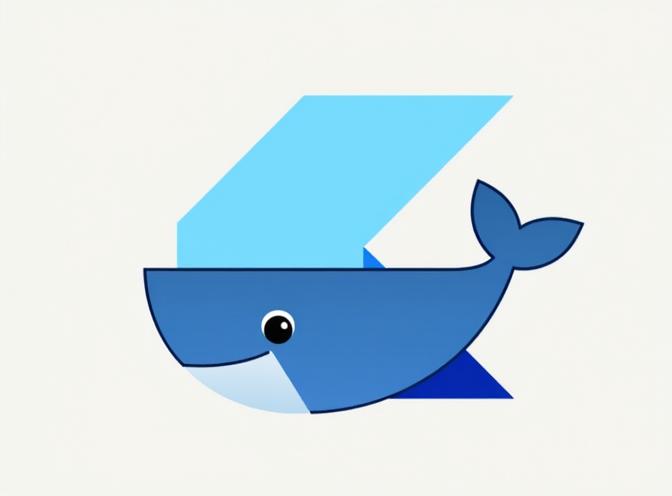Dockerizando um aplicativo Flutter Web com build do Flutter dockerizado e Nginx
Construa e hospede um aplicativo Flutter Web com contêineres Docker
Vários exemplos de Dockerfiles para construir e hospedar aplicativos Flutter web, Imagem de build do Flutter baseada em Ubuntu + Imagem do Webapp no Nginx.

Dockerfile All-in-one
Um Dockerfile típico para construir aplicativos Flutter web pode parecer com o que está abaixo.
Ele usa ubuntu:latest como imagem de build base, instala o Flutter, constrói o aplicativo web e copia-o para a imagem nginx:alpine.
A imagem resultante do aplicativo web hospedado no nginx teria um pouco mais de 73 MB, graças ao tamanho de 48,2 MB da imagem nginx:alpine.
FROM ubuntu:latest AS builder
# Instalar dependências
RUN apt-get update && apt-get install -y \
curl \
git \
unzip \
xz-utils \
zip \
libglu1-mesa
# Instalar Flutter
RUN git clone https://github.com/flutter/flutter.git /flutter
ENV PATH="/flutter/bin:${PATH}"
RUN flutter doctor
RUN flutter channel stable
RUN flutter upgrade
# Adicionar argumento de build
ARG MY_MEGA_API_URL
ENV MY_MEGA_API_URL=${MY_MEGA_API_URL}
# Copiar a fonte do app
WORKDIR /app
COPY . .
# Obter dependências do app
RUN flutter pub get
# Limpar quaisquer builds existentes e construir para web
RUN flutter clean
RUN flutter build web --release --verbose --dart-define=MY_MEGA_API_URL=${MY_MEGA_API_URL}
# Etapa 2 - Criar a imagem final com o nginx para servir os arquivos estáticos
FROM nginx:alpine
# Copiar a build da etapa de construção
COPY --from=builder /app/build/web /usr/share/nginx/html
# Copiar a configuração do nginx
RUN echo 'server { \
listen 80; \
server_name localhost; \
root /usr/share/nginx/html; \
index index.html; \
\
# Lidar com ativos estáticos com tipos MIME apropriados \
location ~* \.(js|css|png|jpg|jpeg|gif|ico|svg|woff|woff2|ttf|eot|json)$ { \
expires 1y; \
add_header Cache-Control "public, immutable"; \
try_files $uri =404; \
} \
\
# Lidar com roteamento do Flutter web \
location / { \
try_files $uri $uri/ @fallback; \
} \
\
location @fallback { \
rewrite ^.*$ /index.html last; \
} \
\
# Cabeçalhos de segurança \
add_header X-Frame-Options "SAMEORIGIN" always; \
add_header X-Content-Type-Options "nosniff" always; \
add_header X-XSS-Protection "1; mode=block" always; \
}' > /etc/nginx/conf.d/default.conf
# Expõe a porta
EXPOSE 80
# Iniciar o Nginx
CMD ["nginx", "-g", "daemon off;"]
Flutter Dockerizado
Mas, se você tiver vários aplicativos Flutter web com os quais está trabalhando, esses arquivos temporários para a imagem de build intermediária consumiriam algum espaço em disco. Faz sentido criar uma única imagem para o build do Flutter e reutilizá-la entre os projetos. A seguir, a imagem abaixo ocupa 3,47 GB no meu PC apenas uma vez.
Aqui está um simples Dockerfile para a imagem de build do Flutter. Salve-o como Dockerfile.flutter.
FROM ubuntu:latest AS builder
# Instalar dependências
RUN apt-get update && apt-get install -y \
curl \
git \
unzip \
xz-utils \
zip \
libglu1-mesa
# Instalar Flutter
RUN git clone https://github.com/flutter/flutter.git /flutter
ENV PATH="/flutter/bin:${PATH}"
RUN flutter doctor
RUN flutter channel stable
RUN flutter upgrade
Vamos construí-lo com
docker build -f Dockerfile.flutter -t rg-flutter:1.0 .
Dockerfile Simplificado para Aplicativo Flutter Web
FROM rg-flutter:1.0 AS builder
# Adicionar argumento de build
ARG MY_MEGA_API_URL
ENV MY_MEGA_API_URL=${MY_MEGA_API_URL}
# Copiar a fonte do app
WORKDIR /app
COPY . .
# Obter dependências do app
RUN flutter pub get
# Limpar quaisquer builds existentes e construir para web
RUN flutter clean
RUN flutter build web --release --verbose --dart-define=MY_MEGA_API_URL=${MY_MEGA_API_URL}
# Etapa 2 - Criar a imagem final com o nginx para servir os arquivos estáticos
FROM nginx:alpine
# Copiar a build da etapa de construção
COPY --from=builder /app/build/web /usr/share/nginx/html
# Copiar a configuração do nginx
RUN echo 'server { \
listen 80; \
server_name localhost; \
root /usr/share/nginx/html; \
index index.html; \
\
# Lidar com ativos estáticos com tipos MIME apropriados \
location ~* \.(js|css|png|jpg|jpeg|gif|ico|svg|woff|woff2|ttf|eot|json)$ { \
expires 1y; \
add_header Cache-Control "public, immutable"; \
try_files $uri =404; \
} \
\
# Lidar com roteamento do Flutter web \
location / { \
try_files $uri $uri/ @fallback; \
} \
\
location @fallback { \
rewrite ^.*$ /index.html last; \
} \
\
# Cabeçalhos de segurança \
add_header X-Frame-Options "SAMEORIGIN" always; \
add_header X-Content-Type-Options "nosniff" always; \
add_header X-XSS-Protection "1; mode=block" always; \
}' > /etc/nginx/conf.d/default.conf
# Expõe a porta
EXPOSE 80
# Iniciar o Nginx
CMD ["nginx", "-g", "daemon off;"]

